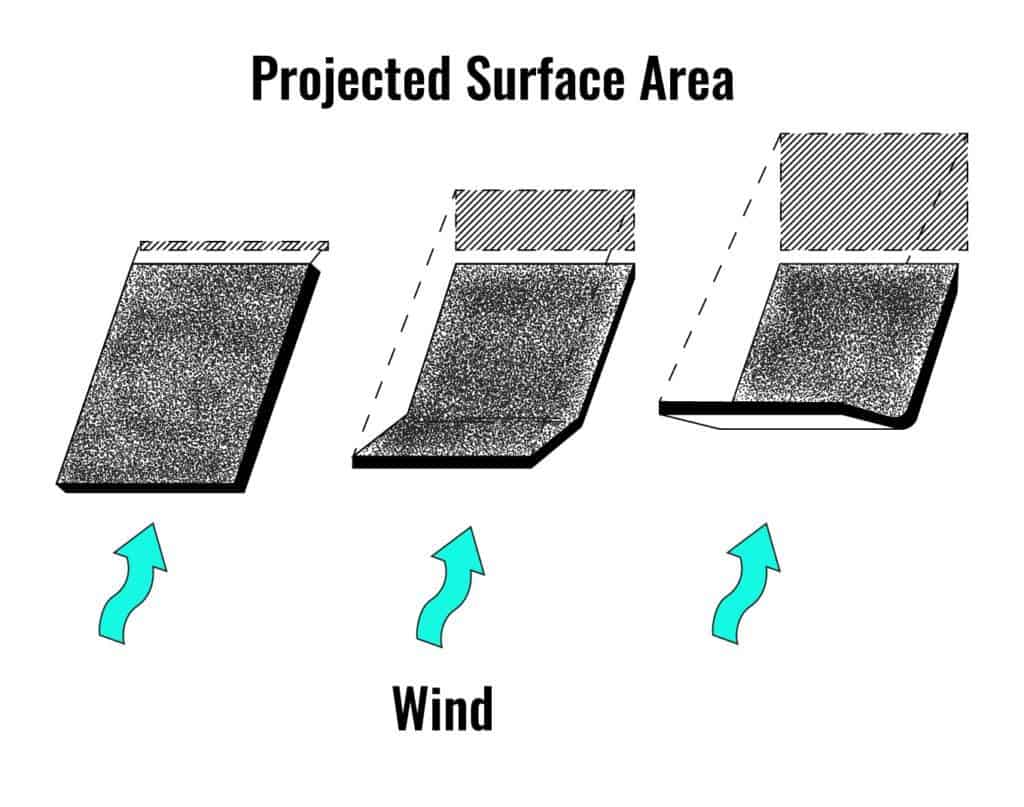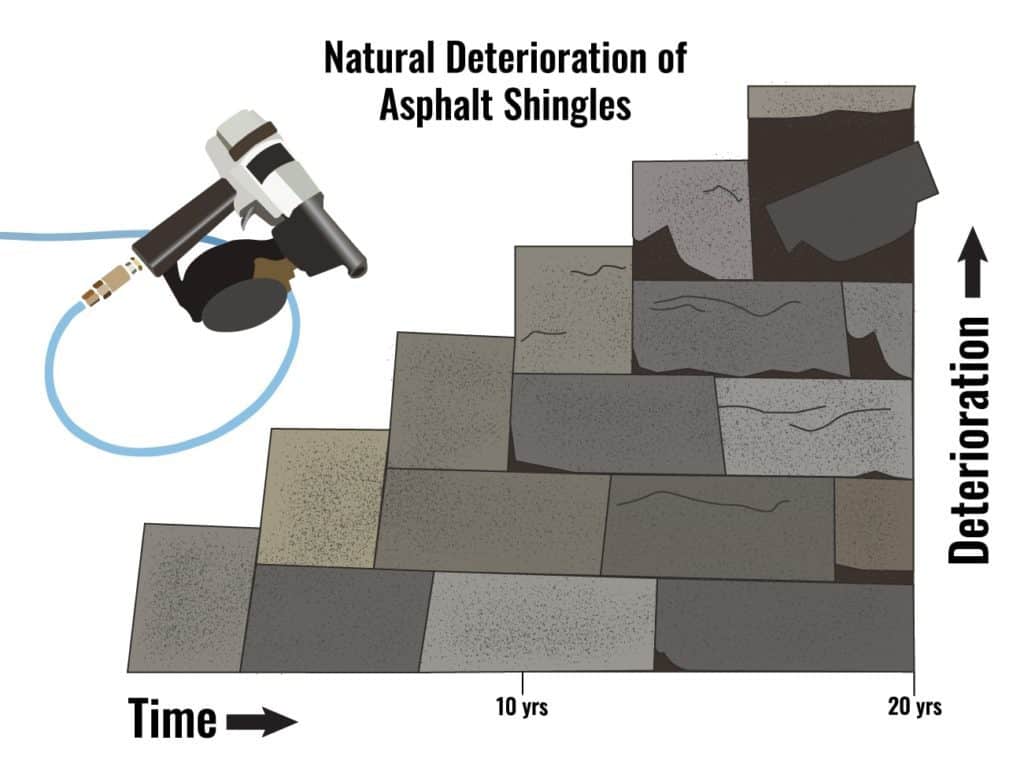What’s Wrong With My Asphalt Roof?
Asphalt shingles are the most used roof covering in the U.S. because of their affordability and versatility. However, there are many issues with asphalt roofing shingles that are falsely attributed to wind damage (Marshall, 2010). What some would call “wind damaged shingles,” are actually results of poor installation, natural aging, weathering, cold weather roofing, faulty glue, and expansion or contraction due to climate changes. Read on to find what qualifies as wind damage and what doesn’t.
How Does Wind Damage Shingles?
If you think you have a wind damaged roof, it could be helpful to know what actual wind damage looks like and how it happens. For a shingle to be wind damaged, an uplift force from the wind has to occur. This causes a pressure disparity between the front and back faces of the shingle. The more the shingle lifts off the roof, the more surface area is exposed between the shingle and the roof, leading to a greater uplift force and faster degradation.

Uplift Explained
As wind blows, it will cause inward and outward pressures on the walls and roof of a building. Any force, including wind, will seek the path of least resistance. This means that when wind hits the side of a house it will move up and over the roof to continue flowing. As it passes the ledge it will create a suction force on the face of the roof, similar to what occurs with an aircraft wing. This is understandable since an aircraft is able to fly due to this uplift force. On a roof, textured shingles begin to lift because of this turbulence and it can cause issues over time. In addition, faulty manufacturing, climate, or installation problems increase the risk of lifted shingles.
Climate Concerns
Expanding and Contracting Cycles
We can’t blame all roofing repair on the wind: some problems stem from environmental temperatures. When shingles start lifting in a uniform, diagonal stairway pattern, they are known as “racked.” When they lift in a straight-up line like a zipper, it is known as “zippering” (go figure!). These are usually a result of repeated cycles of expanding in the heat and contracting in the cold.
Extreme Temperatures
If new roof installation happens in extreme conditions of cold or heat it won’t last as long either. Extreme temperatures will prevent adhesives from bonding and sealants from setting. Thermally protecting your roofing materials will increase their efficiency and durability.
Water Absorption
Other uniform roof anomalies include cupping and clawing, where shingles curl up around all edges of the tab (cupping), or suction downward on all edges (clawing). These most likely have to do with the uneven absorption of water and not with the wind.
How To Spot Wind Damaged Shingles
Wind damaged or wind lifted shingles are not always easy to spot. It is especially difficult to detect wind damage from the ground, and closer inspection is needed.
Creases and Folds
Uplift pressure from suction will first begin to fold shingles upward. If the wind force is strong enough it will fold the shingle until a crease develops. Asphalt textured shingles can hide these folds and creases well. Typically you should be on the lookout for a darker line across the horizontal length of the shingle.
Tears
If a shingle is folded and creased too forcefully and too many times, the area exposed to uplift can tear pieces of the shingle off. If any of your shingles are missing pieces, your wind damage problem is becoming more severe.
Missing Shingles
Extremely high winds will exploit any adhesion flaws and removed shingles entirely. Depending upon the pattern of your shingles, larger sections could be ripped off. If a shingle has others overlapped above them and becomes wind damaged, it can remove the overlapped shingles when it blows off.
Because wind blows in all directions, shingles rarely lift in a uniform fashion. In this case, the line where they lift typically follows the way the contractor installed them.
Additional Weather Damage
Owens Corning is a top producer of asphalt shingles. For detailed pictures and additional descriptions of other types of roof damage, visit Owens Corning’s site.
Wind Pressure Variance
The highest uplift pressures on a roof are in areas of change, such as along corners, eaves, ridges, and rakes (Marshall, 2010). This means that additional anchoring in the areas with the most uplift is extremely important.
How Long Does A Roof Last?
Natural Wear On Shingles
One study by the University of Florida revealed that lifted shingles were more likely due to “a systematic failure of the shingle’s sealant strip” than some other external factor (Dixon, 2013). This is because the sealant strip naturally loses adhesion over time. This natural occurrence leaves the shingle partially unsealed and susceptible to the uplift force of wind and rain.
Dixon et al. (2014) observed that asphalt shingles typically stay sealed for 4 to 5 years, and then begin to naturally deteriorate. The average manufacturer’s estimate for an asphalt shingle roof lifespan is about 20 years. This number obviously fluctuates depending on location and weather conditions.

Faulty Installation And Human Error
The study by Dixon et al. (2014) also found that unsealed shingles can occur from poor installation. 70% of roofs studied showed errors including debris in the sealant strip, under-driven nails, and release tape that was accidentally stuck to the sealant strip from packaging mistakes. These roofs all had a distinct pattern in their damage, meaning they didn’t result from wind (Dixon, 2013).
Roofing contractors need to handle sealants properly to ensure an optimal seal when installing shingles. Contamination to a shingle’s sealant strip can also happen in industrial areas where exhaust or chemical residues are abundant. This can affect a roof even more than weather conditions (2014).
If you’re trying to verify your roofing warranty, it is important to know whether the weather, contractors, or manufacturing are the culprit behind your roofing damage. Don’t let lack of knowledge keep you from having a reliable, economical, and overall good roof!
Powerblanket Roofing Solutions
Powerblanket knows that winter construction can be very difficult, so our cold weather construction solutions are designed with the users in mind. Roofing is one of the most tricky construction projects to attempt during the winter months. There are many thermal elements that wear down a roof’s durability over time. When certain temperature precautions are taken during the installation and repair process, you can prepare your roof to be more wind resistant.
Bulk Material Warmers
Storing shingles, adhesives, sealants and other roofing materials within a warm box greatly increases their usability and durability. Industrial Hot Boxes from Powerblanket protect temperature-sensitive materials during storage, transportation, and on the job site.
Our Hot Boxes provide uniform heat to all materials stored inside. This reduces the chance of having any hot and cold spots. Protect your roofing protect from anything mother nature throws at you and keep jobs on schedule all year long. Contact us today to find the roofing solutions for your needs at 844.280.1276 or [email protected].
Resources
Craig R. Dixon. “The Influence of Unsealing on the Wind Resistance of Asphalt Shingles.” Journal of Wind Engineering and Industrial Aerodynamics. Vol. 130. Elsevier. 2014. pp. 30-40.
“Procedure for an Evaluation of Wind Damage to Shingles.” Prugar Consulting, Inc. Accessed October 11, 2018. http://prugarinc.com/shingles/procedure-for-an-evaluation-of-wind-damage-to-shingles/.
RCI. “Misconceptions of Wind Damage to Asphalt Composition Shingles.” RCI, Inc. June 07, 2018. Accessed October 09, 2018. http://rci-online.org/misconceptions-wind-damage-asphalt-composition-shingles/.
T.P. Marshall, S. Morrison, R. Herzog, and J. Green. “Wind Effects on Asphalt Shingles.” 29th Conference on Hurricanes and Tropical Meteorology. American Meteorological Society. 2010. Hyannis, MA. p. 11.
“What Roof Lasts the Longest?” What Roof Lasts the Longest? – Roofing Southwest. Accessed October 12, 2018. https://www.roofingsouthwest.com/index.php?p=blog/what-roof-lasts-the-longest.
The Powerblanket Hot Box is the perfect solution for your bulk material heating needs.


